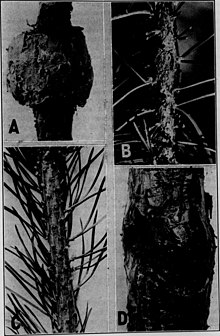
Back Suberien Afrikaans سوبرين Arabic Суберын Byelorussian সুবেরিন Bengali/Bangla Suberina Catalan Suberin Czech Suberin German Σουβερίνη Greek Suberina Spanish Subérine French

Suberin is a lipophilic, complex polyester biopolymer of plants, composed of long-chain fatty acids called suberin acids and glycerol. Suberin, interconnected with cutins and lignins, also complex macromolecules, form a protective barrier in the epidermal and peridermal cell walls of higher plants. Suberins and lignins are considered covalently linked to lipids and carbohydrates, respectively, and lignin is covalently linked to suberin, and to a lesser extent, to cutin.[1][2][3] Suberin is a major constituent of cork, and is named after the cork oak, Quercus suber. Its main function is as a barrier to movement of water and solutes.
- ^ Lewis, N. G.; Yamamoto, E.; Wooten, J. B.; Just, G.; Ohashi, H.; Towers, G. H. (1987). "Monitoring biosynthesis of wheat cell-wall phenylpropanoids in situ". Science. 237 (4820): 1344–6. Bibcode:1987Sci...237.1344L. doi:10.1126/science.237.4820.1344. PMID 17801473. S2CID 20580637.
- ^ Graça, J. (2015). "Suberin: The biopolyester at the frontier of plants". Frontiers in Chemistry. 3: 62. Bibcode:2015FrCh....3...62G. doi:10.3389/fchem.2015.00062. PMC 4626755. PMID 26579510.
- ^ Bernards, M.A. (March 2002). "Demystifying suberin". Canadian Journal of Botany. 80 (3): 227–240(14). doi:10.1139/b02-017.